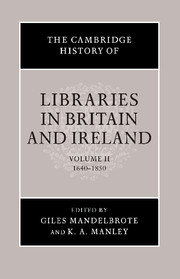Book contents
- Frontmatter
- 1 Introduction: the changing world of libraries – from cloister to hearth
- PART ONE THE EXPANSION OF BOOK COLLECTIONS 1640–1750
- 2 Ancients and moderns: cross-currents in early modern intellectual life
- 3 Libraries, books and learning, from bacon to the enlightenment
- 4 Opportunities for building collections and libraries
- 5 Libraries for school education and personal devotion
- 6 Libraries for the parish: individual donors and charitable societies
- 7 Endowed libraries for towns
- 8 Libraries in university towns
- 9 Ecclesiastical libraries: libraries for the higher clergy
- 10 Libraries for antiquaries and heralds
- 11 Professional collections: libraries for scientists and doctors
- 12 Personal owners of books
- 13 Library buildings and fittings
- 14 Baroque librarianship
- PART TWO LIBRARY DEVELOPMENT AT A LOCAL LEVEL
- PART THREE PROVINCIAL AND METROPOLITAN LIBRARIES 1750–1850
- Select bibliography
- Index
- References
10 - Libraries for antiquaries and heralds
from PART ONE - THE EXPANSION OF BOOK COLLECTIONS 1640–1750
Published online by Cambridge University Press: 28 March 2008
- Frontmatter
- 1 Introduction: the changing world of libraries – from cloister to hearth
- PART ONE THE EXPANSION OF BOOK COLLECTIONS 1640–1750
- 2 Ancients and moderns: cross-currents in early modern intellectual life
- 3 Libraries, books and learning, from bacon to the enlightenment
- 4 Opportunities for building collections and libraries
- 5 Libraries for school education and personal devotion
- 6 Libraries for the parish: individual donors and charitable societies
- 7 Endowed libraries for towns
- 8 Libraries in university towns
- 9 Ecclesiastical libraries: libraries for the higher clergy
- 10 Libraries for antiquaries and heralds
- 11 Professional collections: libraries for scientists and doctors
- 12 Personal owners of books
- 13 Library buildings and fittings
- 14 Baroque librarianship
- PART TWO LIBRARY DEVELOPMENT AT A LOCAL LEVEL
- PART THREE PROVINCIAL AND METROPOLITAN LIBRARIES 1750–1850
- Select bibliography
- Index
- References
Summary
Antiquarian studies in England in the late sixteenth and early seventeenth centuries began to move away from the generalities of monastic chroniclers, and, in a lawyer-like way, towards the verifiable specifics of archival references. The records of the crown emerged as the ideal references for an antiquary. The same zeal for what John Milton was later to call ‘written records pure’ affected the making of family pedigrees by the crown’s appointed officials, the heralds of the College of Arms. In the 1560s Lord Treasurer Winchester had dismissively written of the heralds that they ‘maketh their books at a venture and not by the records’, but now, in the early seventeenth century – following the pioneering work of such men as Robert Glover, Somerset Herald, and William Camden, Clarenceux King of Arms – this was changing, and even the standard heraldic visitation format for each county included record material. The heralds had become antiquaries.
The primary sources that were housed in the crown’s record offices – scattered across London and in several castles or strongholds in the provinces – were enormous in quantity, almost wholly unprinted, and not easily comprehended. The heralds’ salaries from the crown were little more than token annual payments, and their income from their part in heraldic visitations and the ordering of funerals was irregular and precarious. They did, however, possess the expertise necessary for the exploitation of the crown’s ancient records, and since the keepership of a record office was sometimes lucrative it is hardly surprising to find that they quite often secured such posts for themselves.
- Type
- Chapter
- Information
- The Cambridge History of Libraries in Britain and Ireland , pp. 134 - 157Publisher: Cambridge University PressPrint publication year: 2006



